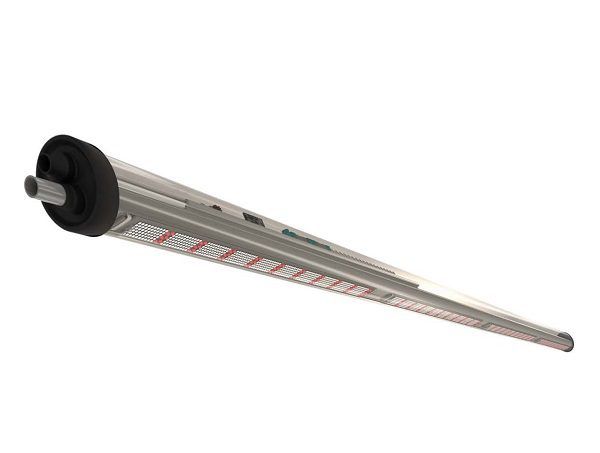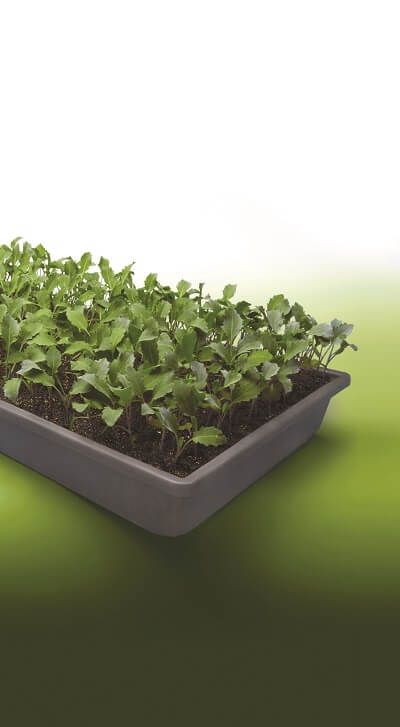Jars, Agnetix Partner For Large-Scale Vertical Farm In Arizona
JARS Cannabis has selected Smart Horticulture Lighting technology leader and Indoor Ag-Con 2022 exhibitor, Agnetix, for a new high-tech vertical farming project in Phoenix, Arizona.
Purpose built for Agnetix lighting, this new state-of-the-art facility will feature over 2000 liquidcooled PHENOM luminaires in a high energy density double-tiered configuration.
JARS Director of Cultivation, Ian Haselmire, spoke about why they were drawn to Agnetix: “JARS began this project with a simple goal: build a highly effective vertical cannabis farm. Vertical growing introduces additional design and operational challenges over single-tiered facilities. We selected the new water-cooled Agnetix PHENOM LEDs for their ability to displace heat before it accumulates inside our tiered benches, maintaining a consistent environment without stagnation and microclimates. The dense array of sensors built into the PHENOM platform further enables us to confirm the effectiveness of our HVAC and supporting equipment, highlighting areas of concern for immediate improvement.”
Dr. Ihor Lys, Agnetix co-founder and CTO, explained: “The Agnetix HMI provides a unique three dimensional view of these sensors, clearly showing the conditions, plants and process in real time. JARS found this capability quite compelling. The PHENOM platform provides unparalleled insight for crop steering, facility management and operational improvement.” Ian continued: “In the short term, this capability speeds commissioning. Every facility goes through
a break-in period, and the faster you can identify areas for improvement the faster you drive the projects’ return on investment.”
For more information about the PHENOM vertical farming lighting systems, visit www.agnetix.com or contact sales@agnetix.com.
About JARS:
Founded in 2020, JARS is a vertically integrated multi-state operator committed to providing the best quality cannabis with the widest variety of options at affordable prices. JARS is a progressive cannabis company that provides a welcoming and uplifting environment for its employees and customers. JARS dispensaries offer an abundance of product choices with knowledgeable staff that can provide insight into customers’ medical and lifestyle needs. Our approach to products, design, and community is helping change the conversation about cannabis in a positive way. In a short amount of time, JARS has built a trusted and powerful brand resulting in rapid growth across multiple states. JARS owns and operates eleven retail locations in Michigan and four retail locations in Arizona, with multiple cultivation and extraction sites in Arizona coming online in early 2022. www.jarscannabis.com
About Agnetix:
Agnetix is a technology company on a steep growth trajectory focused on the development of advanced smart horticultural lighting and information technology solutions for commercial indoor and greenhouse growers – both in fresh produce and cannabis markets. The Agnetix Responsive Agriculture™ platform delivers meaningful plant and energy data insights for quick, informed decisions. The Agnetix system includes highly efficient, water-cooled LED lighting,
environmental sensors, AI (Artificial Intelligence) imagers, data, and real-time monitoring solutions. Agnetix helps serious controlled environment agriculture (CEA) growers to significantly improve their crop yield, reduce their operating cost, reduce their carbon footprint, and run a more profitable business. www.Agnetix.com




 New product line is 40% lighter while retaining trusted strength and durability of MFG’s fiber glass reinforced composite.
New product line is 40% lighter while retaining trusted strength and durability of MFG’s fiber glass reinforced composite. >>Dimensionally stable and exceptional structural strength
>>Dimensionally stable and exceptional structural strength
 From the beginning,
From the beginning,  We founded the company to miniaturize the semi-automation found in commercial-scale farms, at a fraction of the cost and designed it to be controlled via the cloud to allow for aggregated data collection.Today we’ve built and deployed that underlying technology on our fleet of distributed Micro-Farms in North America. We’re just getting started in our journey to apply our underlying technology to different vertical farming systems and in doing so expand the market for sustainable indoor farming.
We founded the company to miniaturize the semi-automation found in commercial-scale farms, at a fraction of the cost and designed it to be controlled via the cloud to allow for aggregated data collection.Today we’ve built and deployed that underlying technology on our fleet of distributed Micro-Farms in North America. We’re just getting started in our journey to apply our underlying technology to different vertical farming systems and in doing so expand the market for sustainable indoor farming. We’re accelerating the commercialization of indoor farming service with hundreds of Micro-Farms being installed in foodservice operations across North America. We’re confident in our technology’s ability to deliver an unparalleled growing experience and it’s exciting to see the data coming in from our growing base of happy customers.
We’re accelerating the commercialization of indoor farming service with hundreds of Micro-Farms being installed in foodservice operations across North America. We’re confident in our technology’s ability to deliver an unparalleled growing experience and it’s exciting to see the data coming in from our growing base of happy customers.

 Our goal has always been to make vertical farming accessible to mainstream markets. We’re proving that it’s commercially viable with our foodservice partners and simultaneously we’re seeing the rapid expansion of the local food movement that’s driving a ton of innovations in the CEA space.
Our goal has always been to make vertical farming accessible to mainstream markets. We’re proving that it’s commercially viable with our foodservice partners and simultaneously we’re seeing the rapid expansion of the local food movement that’s driving a ton of innovations in the CEA space.



 It’s been a fantastic year for us! We opened our largest automated farm in the Fall of 2020, scaling our technology and production 10x greater than prior. Yield, quality, and efficiencies exceeded expectations out of the gate and allowed us to hit our unit economics.
It’s been a fantastic year for us! We opened our largest automated farm in the Fall of 2020, scaling our technology and production 10x greater than prior. Yield, quality, and efficiencies exceeded expectations out of the gate and allowed us to hit our unit economics.
 Retailers and consumers have a growing appetite for fresh food grown indoors. Retailers want fresher food with shorter supply chains to significantly reduce supply inefficiencies, inconsistent quality and reduce food waste. In addition, consumers are more aware of how their food is grown and its effect on the environment. Therefore, they want food grown with zero, not fewer, pesticides with the highest nutritional value and grown close to store for longer-lasting freshness.
Retailers and consumers have a growing appetite for fresh food grown indoors. Retailers want fresher food with shorter supply chains to significantly reduce supply inefficiencies, inconsistent quality and reduce food waste. In addition, consumers are more aware of how their food is grown and its effect on the environment. Therefore, they want food grown with zero, not fewer, pesticides with the highest nutritional value and grown close to store for longer-lasting freshness.

 ground on the world’s largest and most technologically advanced
ground on the world’s largest and most technologically advanced  We are thrilled to announce our merger with Spring Valley Acquisition Corp, who shares the same ESG philosophies to make a positive impact on the world, while serving the interests of our shareholders. AeroFarms’ mission is to grow the best plants possible for the betterment of humanity, and we are executing on this by taking agriculture to new heights with the latest in technology, innovation and understanding of plant science.
We are thrilled to announce our merger with Spring Valley Acquisition Corp, who shares the same ESG philosophies to make a positive impact on the world, while serving the interests of our shareholders. AeroFarms’ mission is to grow the best plants possible for the betterment of humanity, and we are executing on this by taking agriculture to new heights with the latest in technology, innovation and understanding of plant science. mission of growing the best plants possible for the betterment of humanity. Our customers love our leafy greens, which consistently win on quality, flavor, taste and texture. We are excited to break ground on our new farm, expand our retail presence in the region and bring our exceptional, great tasting products to more customers. Danville-Pittsylvania County is the perfect location to introduce our next-generation Model 5 farm that will be able to serve the more than 1,000 food retailers in the region.
mission of growing the best plants possible for the betterment of humanity. Our customers love our leafy greens, which consistently win on quality, flavor, taste and texture. We are excited to break ground on our new farm, expand our retail presence in the region and bring our exceptional, great tasting products to more customers. Danville-Pittsylvania County is the perfect location to introduce our next-generation Model 5 farm that will be able to serve the more than 1,000 food retailers in the region. On March 11, 2021 two international industry leaders,
On March 11, 2021 two international industry leaders, 